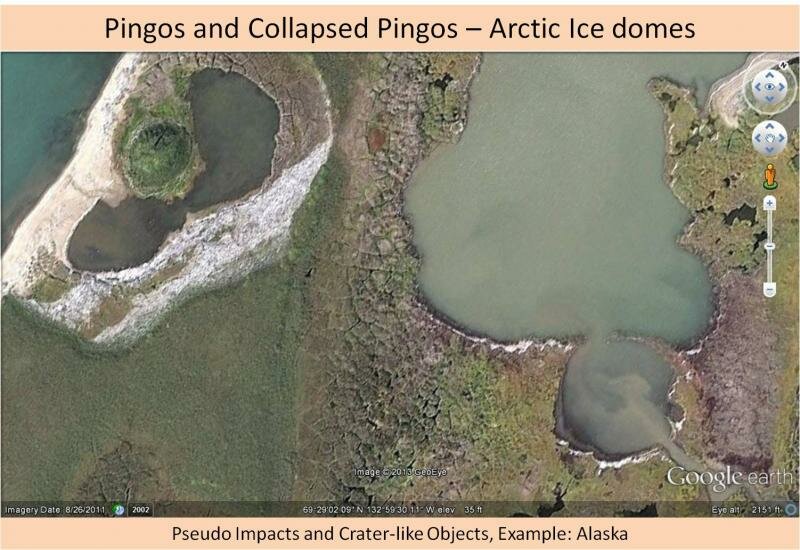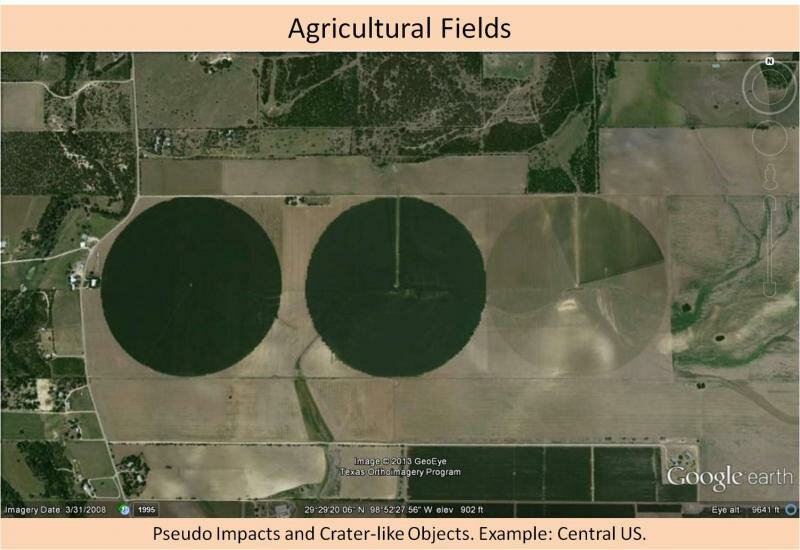United States Meteorite Impact Craters
- Home
- Craters Introduction
- Impacted Rocks
- Ames, Oklahoma
- Avak, Alaska
- Barringer, Arizona
- Beaverhead, Montana
- Chesapeake Bay, Virginia
- Cloud Creek, Wyoming
- Crooked Creek, Missouri
- Decaturville, Missouri
- Des Plaines, Illinois
- Flynn Creek, Tennessee
- Glasford, Illinois
- Glover Bluff, Wisconsin
- Haviland, Kansas
- Kentland, Indiana
- Manson, Iowa
- Marquez, Texas
- Middlesboro, Kentucky
- Newporte, North Dakota
- Odessa, Texas
- Red Wing, North Dakota
- Rock Elm, Wisconsin
- Santa Fe, New Mexico
- Serpent Mound, Ohio
- Sierra Madera, Texas
- Upheaval Dome, Utah
- Wells Creek, Tennessee
- Wetumpka, Alabama
- Unconfirmed Impacts
- The Ozarks Region
- Glossary
- About This Website
Pseudo-impacts and Crater-like objects
Not everything that looks like an impact is an impact. Forces ranging from sudden volcanism to seasonally swelling ice, and from the slow movement of heaving salt to gradual erosion by wind and water can all produce crater-like structures. Following up on the ones listed below, using wikipedia and then google or other searches in order to understand how, where, and why they form, may allow the reader to discern what may or may not be dianostic criteria for each of these forms, both at ground level and from an aerial view. Each is different from the other. Eroded sedimentary layers, for instance, typically form circles around hills, not bowls, and can be distinguished by the visible continuation of sedimentary layers on surrounding rises. On the ground, the rock distinctions themselves can be seen. Phreatic (steam) eruptions are probably the most ridiculously confusing of all of these forms, since they can occur in non-igneous rocks, produce breccias, raised rims, and simple explosive bowls surrounded by ejecta. They do not, however, produce the shock results, at a grain scale, that can be seen in materials metamorphosed under and around a hypervelocity impact site. The appearance of individual examples of each of the structures below can vary significantly, so be sure to follow up with searches if you are interested.
Many of these can be identified by considering their context. Volcanic craters are found, for instance, in volcanic regions. Others, while not necessarily intuitive, yield to basic searches. The basic, descriptive search terms 'hole in the ground Missouri' will quickly link you to a number of starting points to understanding sinkholes.
Google Earth is a great tool for learning about these objects. In fact, it may be the greatest tool yet invented for the task. The GPS coordinates are listed in the images, and visiting the areas in which the shown objects are found is a great way to get started in understanding what other, similar objects may look like.














Copyright 2011 United States Meteorite Impact Craters. All rights reserved.